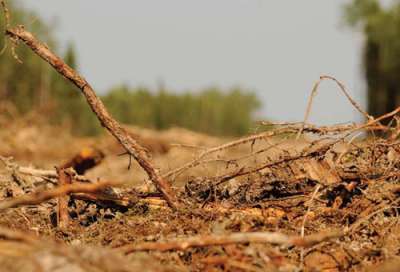Although the word is related to scarring – something you’d think we’d want to avoid – soil scarification [pronounced scare-ification] is a legitimate silvicultural technique that is sometimes necessary for regenerating native trees. But as with so many aspects of forestry, when misunderstood or poorly applied, soil scarification can indeed be scary, bringing with it a host of unintended consequences.
Regeneration – the successful establishment of new seedlings capable of growing up to be the future forest – is a forester’s most fundamental responsibility. But it is far from easy; it depends on careful attention to the ecological requirements of each tree species and a firm understanding of how to create the right conditions for the species you want to grow.
Silvicultural soil scarification involves disturbing the forest floor in a controlled way. It is used to rearrange some of the leaf litter, mixing it with – and exposing – the mineral soil below. Foresters employ skidders, dozers, tractors, or horses to prepare the forest floor, scuffing the ground surface with the equipment itself or with materials dragged behind – from trees to bedsprings.
Natural (and less controlled) scarification happens when trees are uprooted by wind, when heavy rains or snowmelt carry leaves and needles downslope, or, say, when a flock of turkeys moves through the woods, scratching away leafy debris in search of insects and seeds to eat. Such disturbances – be they natural or manmade – alter the prospects for tree seedling success in subtle but profoundly important ways.
Before the litter layer is scarified, only certain tree seeds can successfully germinate. A relatively large, heavy seed like an acorn might have enough energy and a strong enough first root to make its way through a mat of decaying leaves and twigs and into the more abundant moisture and fertility of the mineral soil below. But small- and light-seeded species such as white pine, paper birch, and hemlock, are notoriously ill-suited for such conditions, and their seeds often dry out and die if they land on undisturbed leaf litter. Scarification creates highly suitable seedbeds, and when the seeds of birch, pine, and hemlock land on bare mineral soil, their seedlings can outgrow those of other trees. This explains those veritable rivers of pine or birch saplings that so often colonize old skid trails snaking through the woods.
Does this mean that we can best manage for light-seeded species by driving heavy machinery throughout the woods, crushing plants and rutting and compacting soil with impunity? Hardly. Successful scarification is not automatic and it’s not an excuse to rip up the woods. When misapplied, it can result in soil erosion and compaction, damage to remaining trees, the uprooting or damaging of seedlings, unwanted expansions of weeds or invasive plants, the stimulation of unwanted noncommercial trees, a loss of stored soil carbon, and who knows what sorts of problems for the little-known world of soil microbes and invertebrate animals.
Legitimate scarification requires thoughtful planning and careful execution under appropriate circumstances. We know that felling large trees and pulling or even carrying them out of the woods is disruptive and must be carefully controlled. That’s why, on balance, unintended damage during logging is minimized when harvests are conducted in the dormancy of winter over snow-covered, frozen terrain.
But in some ground conditions and in some forest types, winter logging can present an obstacle for regeneration because the very attributes that protect the ground make scarification almost impossible. The forester often has better prospects for successfully regenerating light-seeded species on summer ground, when planned scarification is more likely, especially if it is thoughtfully applied and well timed to coincide with a good crop of newly fallen seeds, ready to grow.



Discussion *